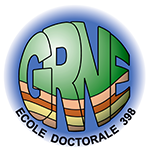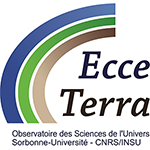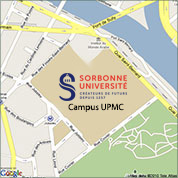Webinaire ISTeP - Stephen Centrella

(Université Pau et Pays de l'Adour)
Stress, fluid and metasomatism
Fluid-rock interaction processes at all scales (i.e. from the grain size to lithospheric scale) play a key role in the Earth’s crust. They are related to changing the rheology of rocks with earthquakes, responsible for magma generation and arc volcanism, the formation of ore deposits and the global geochemical cycles. Despite recent advances in experimental petrology and numerical modelling, it remains challenging to quantify mass transfers, because detailed information regarding the evolution of the mechanical properties of the rocks during fluid-rock interaction at depth (e.g. density and volume) are lacking. This is mainly due to the petrological modelling techniques that are all based on the thermodynamic analysis of single rock types and neglect the chemical changes caused by fluid infiltration/expulsion and the possible interactions with other rocks. They use a system with constant mass without considering chemical and physical changes (microstructure) caused by (de-)hydration reactions.
The Bergen Arcs is located in the western coast of Norway near the city of Bergen. This region represents the root of a mountain belt (Caledonides) and is characterised by partial hydration reaction. The original granulite (~900 Ma) is partially hydrated into eclogite and amphibolite-facies rock (~430 Ma). It is easy to find and to follow the transitions from granulite to eclogite and eclogite to amphibolite where the foliation is continuous. It suggests that we are not dealing with a simple P-T path where granulite was eclogitized at high pressure and retromorphosed at lower pressure at amphibolite-facies conditions. Because the interface between these three metamorphic facies is very sharp, it provides an exceptional site to determine the mechanism of metamorphic reactions. Using chemical analyses, mass balance equation and thermodynamic modelling approach, results show that eclogite and amphibolite paragenesis seem to be form at the same temperature, redox conditions, same fluid composition (CO2-H2O ratio and element mass transfer). Unfortunately, we still must deal with 10 kbar of pressure difference between eclogite and amphibolite. These results challenge the way we use to interpret thermodynamic pressure to build geodynamic model since eclogite and amphibolite seems to be form at the same temperature, redox conditions, same fluid composition (CO2-H2O ratio and element mass transfer). It also shows that the overall system must be open since mass is lost through the fluid phase. In specific case, amphibolitisation loses until 13% of mass.
At smaller scale, quantitative mass transfer and associated volume variation were performed for different reaction within the same thin section and potentially related to the same event. Centimetre-sized grains of Al-rich clinopyroxene within the granulitic of the Bergen Arcs undergo deformation by faults and micro-shear zones (kinks) along which fluid has been introduced. The clinopyroxene reacts to the deformation and hydration in two different ways: reaction to garnet (GrtII) plus a less aluminous pyroxene (Cpx) along kinks and the replacement of the Al-rich clinopyroxene by chlorite along cleavage planes. The first reaction loses volume and gains density and the second gains volume but loses density. More surprisingly, the specific mass behaves in the same way for the two reactions. The only difference found between the two reactions is the local variation of stress-strain proved by misorientation map. Modelling of phase equilibria suggest that the thermodynamic pressure of the assemblage within the kink is ~6 kbar higher than the pressure conditions for the whole rock for the same range of temperature (~650 °C). This result suggests that the stress-strain redistribution within a rock may play a role in determining the reactions that take place during retrograde metamorphism.
Ce webinaire se tiendra en ligne uniquement à partir de 12h30 via le lien Zoom ci-dessous.
Sujet : Webinaire Stephen Centrella
Heure : 18 févr. 2022 12:30 PM Paris
Participer à la réunion Zoom
https://us02web.zoom.us/j/86171904596?pwd=cFBtQlFNYzNXZFBaN0hDSmp6dDNFZz09
ID de réunion : 861 7190 4596
Code secret : M3vRXw
Egalement dans la rubrique
- Séminaire ISTeP - Aurélien Beaumais
- Séminaire ISTeP - Céline Baudouin
- Séminaire ISTeP - Bruno Scalabrino
- Séminaire ISTeP - Matilde Ferrante
- Séminaire ISTeP - Guillaume Bonnet
- Séminaire ISTeP - Gaétan Milesi
- Séminaire ISTeP - Olivier Galland
- Séminaire ISTeP - Julien Charreau
- Séminaire ISTeP - Marine Paquet
- Séminaire ISTeP - Fabio Speranza
- Séminaire ISTeP - Philippe Yamato
- Séminaire ISTeP - Manon Delaison
- Séminaire ISTeP - Frauke Klingelhoefer
- Séminaire ISTeP - Geoffroy Mohn
- Séminaire ISTeP - Leïla Ben Khelifa
Chiffres clés
L'ISTeP comprend 108 membres dont :
- 12 professeurs
- 21 maîtres de conférences
- 2 directeurs de recherche CNRS
- 2 chargés de recherche CNRS
- 7 ATER et post-docs
- 26 doctorants
- 21 ITA-IATSS
- 17 collaborateurs bénévoles / émérites





